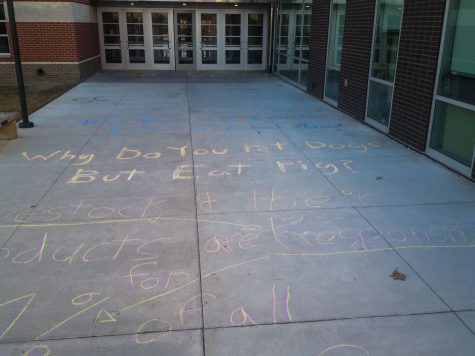Social media habits require new methods of discipline
Last September, parents filed into Southwest and South middle schools for a meeting geared towards discussing the realities of what their children were doing on social media and explaining how to use social media safely. The meetings were followed by presentations to all grade levels.
“The second piece is grade level presentations … the conversation that’s shared is pretty much the same, it’s a stronger message at each grade level, depending on what they’re ready to hear,” USD 497 Health and Wellness Administrator Denise Johnson said.
The meetings were led by Lawrence Kansas Police Department (LKPD) officer David Garcia and by each school’s resource officer. Meetings are planned for Liberty Memorial and West middle schools in February of 2016. The meetings are designed in part to address sections of the national sexuality education standards that students grade 6-8 should be taught, namely those involving social media. The meetings took on a more official capacity this year, though school resource officer (SRO) Ty Scheibler conducted a similar meeting at Southwest last year.
Though the meetings served a purpose in meeting nationally mandated standards, it was not their sole objective. Those involved hoped to educate both parents and students on the current state of students’ social media usage and digital citizenship.
“[We are] trying, basically, to educate the parents on what their kids are actually on, and what’s maybe ‘PG,’ what’s ‘PG-13,’ and what’s, okay, now they’re maybe messing in some stuff that [they shouldn’t],” Scheibler said.
Johnson found it critical to ensure that any preventative measures that could be taken were, given the possible severity of both disciplinary and principal action that could arise. In this, there has been some success.
“When I first became an SRO, I would go to Southwest over a lot of social media stuff that I don’t really have to go to now,” Scheibler said. “[In the meetings], I took advantage of talking about the sexting on social media, and I branched that in to bullying, because they all do, somewhat, go together.”
The meeting that Scheibler gave last year was in response to issues at Southwest regarding sexting, and the meetings now encompass any action on social media that is unsafe, illegal, or disrespectful. Johnson also stresses the less literal problem of the permanence of expression when done online. In the past, she says, action or speech was, in all but the most serious circumstances, temporary.
“Years ago, you would pass a note,” Johnson said. “The note would be grabbed by the teacher and thrown in the trash, or read and you’d get giggled at, and it would be over. Now, what we’re trying to stress to the kids, is when you send things through digital media, that’s your footprint. That’s there forever.”
This permanence and accessibility also changes the way expression is viewed in the eyes of authority, be it school administration or the law. Scheibler noted the necessity of educating students on the way the law will interpret action taken through digital media.
“When you take that photo of yourself and you’re under 18, and you send it to somebody, that’s child porn,” Scheibler said.
According to Scheibler, sexting also blurs the line between the victim and the instigator. It is difficult to impartially separate the idea that the sender can easily be taken advantage of from the idea that they also jeopardize the receiver by providing them child pornography.
Another area that digital media muddles is threats made against person or property, especially in the cases of bombing or shooting threats on school grounds. With the advent of social media, these threats are made publically far more often, and remain more accessible for others, including law enforcement. When it comes to a violent threat, the school administration usually receives a tip from a friend, teacher, or otherwise, and then the perpetrator of the perceived threat is spoken to before and legal proceedings begin. Often, these proceedings never do.
“Once it comes to us… we just have to treat it kind of full bore, pull kids in, and find out exactly what happened,” Scheibler said. “That can involve going through their phone, their computer, maybe getting a search warrant, or getting parent’s consent.”
It is also much more difficult to determine whether a perceived threat is genuine, merely an exaggerated expression of frustration, or entirely facetious.
“I think the reality of it is, is what we may have been able to blow off as a joke ten or fifteen years ago compared to what we can now, we basically just have to treat it all as [a genuine threat],” Scheibler said. “You kind of have to take it at face value.”
Both Scheibler and Johnson say that students and parents both should adjust their behavior to reduce the number and severity of problems that occur. Johnson put together the meeting with the hope that edifying students in the meaning of the law is vitally important for the development of their understanding of digital citizenship.
“Students need to understand what the law states, what you can and can’t do, the fact that digital citizenship is there, and it will be there forever,” Johnson said.
Johnson is also in favor of parents being more involved with their children’s online presence, and understanding fully the forms and facets this presence can display.
“One of the messages that [we] share is for parents to be a part of… all the different pieces of social media, and to not let their child say ‘that’s invasion of my privacy’ and for [them] to absolutely be a piece of that.”
Students, however, may have a different take on the level with which their parents, teachers, or administrators should be involved with their online activity. Scheibler especially underscores the idea that a line must be drawn between involvement and overinvolvement.
“[Parents] need to watch what [students] are posting, but we have some parents in this school, and I’ve had some at Southwest, that read their kid’s texts, and stuff like that,” Scheibler said. “To me, I think if you occasionally want to do something like that, okay, but to read every kid’s texts, back and forth, those are helicopter parents that are way too involved.”
The main objective is simple prevention. The full education of students, according to Johnson, will ensure vast amounts of problems will be avoided before they occur. The presentations at the middle schools are a prime example of these attempts to educate. Scheibler also singles out a problem in the way all people treat social media, as simply a way to share your thoughts or speak what’s on your mind. He argues that one must be more filtered than that, as it is available to the public and not treated only as thought in the eyes of the law.
“The biggest thing I would tell the kids… is to pause. Literally, you’re thinking about something, you want to react… right away want to jump on it. Maybe you just need to pause a second.”









